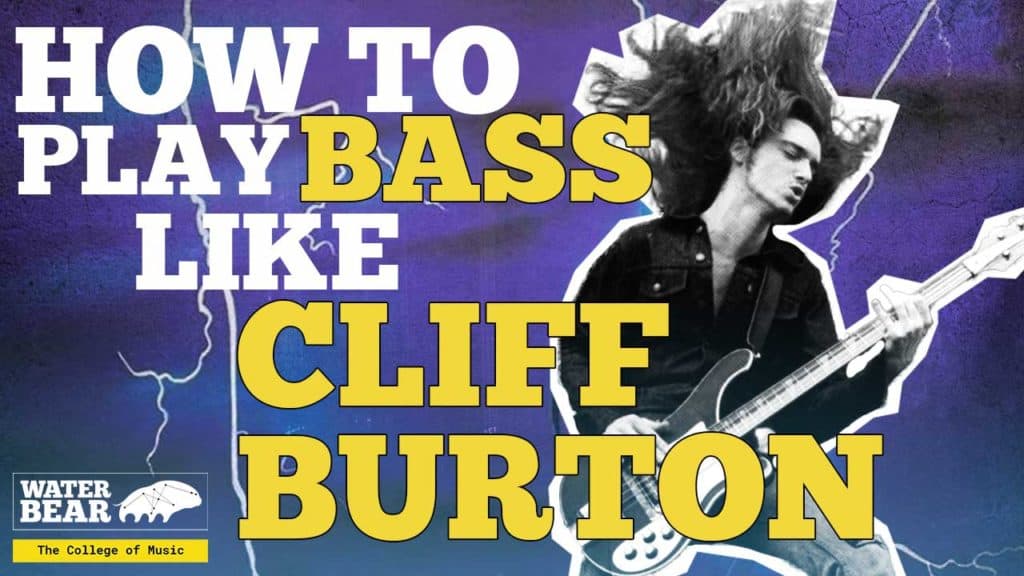JOIN US SEPTEMBER 2024 - APPLY TODAY OR BOOK YOUR PLACE ON ONE OF OUR OPEN DAYS IN BRIGHTON OR SHEFFIELD
JOIN US SEPTEMBER 2024 - APPLY TODAY OR BOOK YOUR PLACE ON ONE OF OUR OPEN DAYS IN BRIGHTON OR SHEFFIELD

The silhouette of Cliff Burton has loomed large over rock since his playing burst onto the scene with Metallica’s ‘Kill ‘Em All’ in 1983. Burton’s tragic death in Sweden in 1986 (aged only 24) brought an untimely end to his career, but he did release three albums with Metallica: Kill ‘Em All (1983), Ride the Lightning (1984) and Master of Puppets (1986).
His legendary stage presence revealed an aggressive and technically adept attack combined with a keen attention to harmony and composition. This propelled Metallica’s music to heights beyond their peers with Master of Puppets regularly featuring amongst the best thrash metal albums ever recorded.
So how can we bring some of Cliff’s approach to our own playing? Burton’s style had much more to it than simply brute aggression, and to get a full measure of the man we need to examine his influences and how he started on the instrument.
Born on February 10th, 1962 in Castro Valley, California, Clifford Lee Burton’s first exposure to music came from his father’s introduction to classical music. Piano lessons quickly followed, and Burton progressed quickly. It was the death of his older brother to a brain aneurysm at the age of 16, however, that brought 13-year-old Burton to the bass, telling people that ‘‘I’m gonna be the best bassist for my brother.”
Burton threw himself into the instrument and he soon became more able on bass than his early teachers, leading him to take lessons with jazz teacher Steve Doherty. It was Doherty that encouraged Burton to read music and study the works of classical composers.
Gigs with his first bands across the Bay Area and a short tenure at college studying classical music and theory (before quitting to become a full-time musician) brought a fully formed Cliff Burton to the attention of Lars Ulrich and James Hetfield. He joined Metallica in March 1983.
As a listener to music across many genres, Burton has cited Geddy Lee, Geezer Butler, Stanley Clarke, Lemmy and Phil Lynott as influences and these are evident in his note choice, technical prowess and aggressive tone. Let's have a closer look at some of Cliff’s signature and iconic techniques.
Geddy Lee and Geezer Butler’s influences upon Cliff have been evident from the very beginning of Metallica’s discography. ‘(Anesthesia)—Pulling Teeth’ from Kill ‘Em All is a four-minute-long bass solo, containing a compilation of solos across Cliff’s live performances. The first two and half minutes is purely Cliff, before Ulrich joins in on the drums and allows the listener the perfect insight into Burton’s approach. The tone is huge, especially when he really opens up the wah at around 00:37, provided by his Morley Power Wah Boost pedal. His Rickenbacker bass is run through an EHX Big Muff to give his signature biting growl.
The piece starts off with a series of major and minor pentatonic arpeggios, diatonic to the key of D Dorian before moving into time signatures that shift between 3/4, 5/8, 5/4 and 11/8 (00.56). Counting these changes is not easy, but the use of arpeggios gives the part an inherent pattern which we can rely on to get us through them. Count the repetition of the shapes as opposed to the number of beats in a bar - I’m pretty sure this is how Cliff counts his way through.
The solo then progresses through passages of triplets, chordal playing, tapped harmonics and fast melodic lines. There is plenty of material to look at, but I suggest that you cherry pick your favourite passages and work on these in isolation, at a variety of keys and tempos. This will really embed the phrases into your muscle memory and enable you to play them effectively at your next gig.
Orion from the 1986 album Master of Puppets is another Burton piece that lets us have a look at his composition and band arrangement skills. It’s the second longest track on the album and is full of nice moments from Cliff, including arpeggios, chords and a bass solo double tracked with a harmony part. The bass often takes the lead role (that’s Cliff you can hear playing the melody at 01:42), but it is the chordal section at 03:59 that I would really like to focus on.
Moving from the big riffs in 4/4, the arpeggios are played in 6/8 which gives the piece a more relaxed feel. Again, Burton uses his theoretical knowledge to ensure that the chords all belong to the key same key - F#m in this case. The bass line is a lot of fun to play, using root and fifths to create a flowing line. Make sure that all the strings ring over each other to allow the lister to hear the chord in its entirety. The dotted notes need to be played precisely at this moderately fast tempo and there are some nice minor pentatonic fills interspersed between the arpeggios. This requires a different hand position, so make sure you are prepared for them!
Burton’s impressive playing can really be heard clearly in the two passages’ details above, but it’s in his more traditional bass role that I feel he really shines, providing the rhythmic and harmonic link between Ulrich and Hetfield. Creeping Death, from the 1984 release Ride the Lightning is played at a blisteringly fast 198bpm. Burton was never known to use a plectrum, but this did not hold him back from keeping pace with the guitarists, throwing in high register fills and huge sounding chords for good measure.
The riff at 00:30 of the title track Master of Puppets is another good example. Listen carefully and you can hear that Burton doesn’t play a note-for-note version of the riffs with the guitarists as you would expect him to. He approaches the part with a more harmonic sensibility, using his note choice to create the chords F5 and Db/F instead. Apart from making the part more interesting, the chord changes make the riff sound more sinister and menacing.
Despite holding the bassist role for the shortest time, Burton’s presence is still profoundly felt with Metallica, and across the world of metal as a whole. A reader poll organised by Rolling Stone magazine placed him as the ninth greatest bass player of all time and his hometown of Castro Valley pronounced his birthday of February 10th as ‘Cliff Burton Day’.
When asked for his advice to young musicians, Burton replied: “When I first started, I decided that I would devote my life to it.” Devotion, he said, was the key. “To absolutely devote yourself to that, to virtually marry yourself to what you’re going to do and not get sidetracked by all the other bulls**t that life has to offer.” We may have been stripped of the chance to see how Burton’s talents may have developed over the last 35 years, but he achieved remarkable highs tirelessly working on and pushing his craft to the limits - this is how his legacy truly remains.
Basses
1982 - Burgundyglo Rickenbacker
Neck position pickup: Gibson EB ‘mudbucker’ humbucker
Bridge position pickup: Seymour Duncan Stacked Jazz Bass pickup
Third stacked Seymour Duncan Stratocaster pickup installed in place of the Rickenbacker’s foam mute and activated by a push-pull knob
1985 - Aria SB Black N’ Gold (Cliff Burton signature bass)
Occasionally used: Alembic Spoiler II (stolen from Burton's car in 1985 and never seen again)
Amps
1983 - Sunn Beta Bass Amp and a Peavy Mark IV Series 400 head with stock cabs
1986 - Two valve powered Mesa Boogie D-180 heads, with one being used for a clean signal and the other processing the effects chain.
Speaker cabinets: Mesa Boogie 4″x12″ in conjunction with a 1″x15″
Effects
Morley Power Wah Boost
Boss CS-2 Compression Sustainer
Electro-Harmonix Russian Big Muff
Ibanez HD1500 Harmonics/Delay Rack Unit
To find out more, check out our courses here.

- ‘Water bear’ is the common name for a Tardigrade.
- Tardigrades are micro creatures, found everywhere on earth.
- They are the most resilient creatures known.
- They can survive and adapt to their surroundings, even in outer space.
- Their resilience and ability to adapt and survive inspires us in everything we do. We love them.


WaterBear Education Ltd, Hanover House,
118 Queens Road, Brighton BN1 3XG, UK Map
Email: [email protected]
Tel: +44 (0) 1273 726230
WaterBear Sheffield, Unit 4, Gatecrasher,
49 Eyre Lane, Sheffield S1 4RB, UK
Email: [email protected]
Tel: +44 (0) 1143 992720

WaterBear Education Ltd, Hanover House,
118 Queens Road, Brighton BN1 3XG, UK Map
Email: [email protected]
Tel: +44 (0) 1273 726230
WaterBear Sheffield, Unit 4, Gatecrasher,
49 Eyre Lane, Sheffield S1 4RB, UK
Email: [email protected]
Tel: +44 (0) 1143 992720
- ‘Water bear’ is the common name for a Tardigrade.
- Tardigrades are micro creatures, found everywhere on earth.
- They are the most resilient creatures known.
- They can survive and adapt to their surroundings, even in outer space.
- Their resilience and ability to adapt and survive inspires us in everything we do. We love them.
